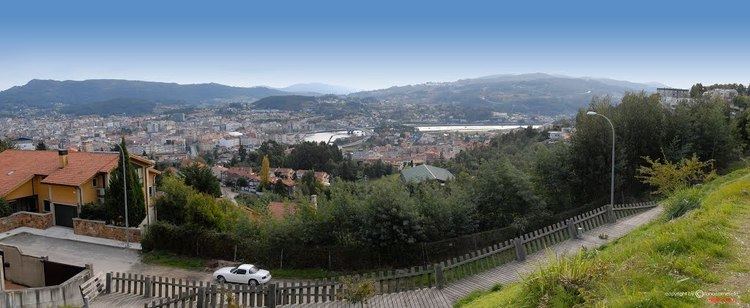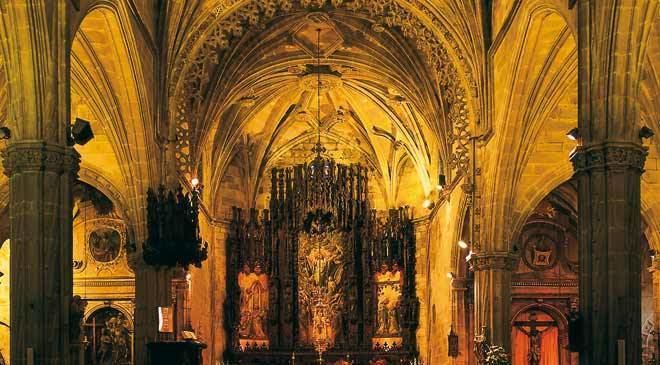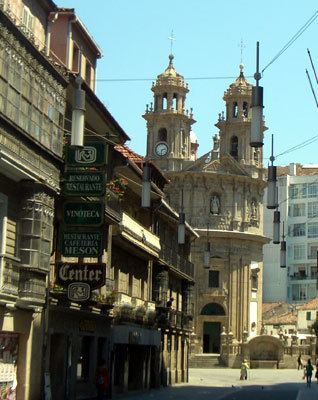Country | Population 82,684 (2012) Area 118.3 km2 | |
 | ||
Mayor Miguel Anxo Fernandez Lores (BNG) | ||
Map of Pontevedra
Pontevedra ([ˌponteˈβɛ.ðɾa], [ponteˈβeðɾa]) is a Spanish city in the north-west of the Iberian Peninsula. It is the capital of both the Comarca (County) and Province of Pontevedra, and of the Rias Baixas in Galicia. It is also the capital of its own municipality which is, in fact, often considered as an extension of the actual city. Pontevedra is the provincial district court seat.
Contents
- Map of Pontevedra
- Pontevedra spain
- Toponymy
- Location and subdivisions
- Population
- Climate
- Transport
- Economy
- History
- Governance
- Health education and culture
- Sights
- Sports
- Sister cities
- Notable people
- References

Pontevedra has transformed into one of the most accessible cities and has been awarded for its urban quality international prizes like the European prize, "Intermodes" in Brussels in 2013, the United Nations Habitat prize in Dubai in 2014 and the "Excellence Prize" of the Center for Active Design in New York City in 2015.

Pontevedra spain
Toponymy

The name of the city is likely a Latin composite of pons, pontis (bridge) and veter, vetera, veterum (old, long established). In Galicia, Latin pons, a masculine word, became feminine, hence Vulgar Latin Ponte Vetera, which became by the 13th century the modern Galician language toponymy Pontevedra, "the old bridge", in reference to an old Roman bridge across the Lérez River which had been located near the 12th century Burgo Bridge that remains in place today.
Location and subdivisions

The municipality of Pontevedra is located between 42°20' and 42°30' north and 8°33' and 8°41' west, in the southwestern Galician coast, an area popularly known as Rias Baixas. The municipality covers 118.3 km² and is about 20 km wide from north to south.
The city sits at the end of the ria that bears its name, occupying the valleys of the Lérez and Tomeza rivers. It extends southwards to the mouth of river Verdugo in Ponte Sampaio. It is surrounded by four mountainous regions divided by two faults, one stretching north-south and one from northeast to southwest.
To the north it borders the municipalities of Barro, Moraña and Campo Lameiro; to the east, Cotobade and Ponte Caldelas; to the south, Soutomaior, Vilaboa and Marín, and to the west, Poio and the ria, leading to the Atlantic Ocean.
The main parroquias (parishes) of Pontevedra are: Alba, Bora, Campañó, A Canicouva, Cerponzóns, Estribela, Lérez, Lourizán, Marcón, Mourente, Ponte Sampaio, Salcedo, San Xosé, Santa María de Xeve, Tomeza, Verducido, Xeve.
The neighbourhoods or main areas of Pontevedra are: O Burgo, Monteporreiro, Campolongo, Mollabao, A Seca, Salgueiriños, A Parda, Gorgullón. The residential area of A Caeira, although officially located in the municipality of Poio, is often considered as just another neighbourhood of Pontevedra since the vast majority of the residents work in Pontevedra and relate to the city.
Population
The municipality of Pontevedra is composed of the city of Pontevedra and fifteen rural parishes in close proximity, with a total population of 82,946 (as of 2014). This results in a relative high density of population of 710.1 inhabitants per square kilometre. More than two-thirds of the population live in the city, and less than one-third in the rural parishes.
The population of Pontevedra is aging, with generational replacement is not necessarily assured, although the city's population has been gradually growing in recent years. Broken down by age, 15.93% of the population were senior citizens, 69% between 15 and 65 years, and just 15.01% under the 15 years of age. The natality rate (9.8‰) is only +1.8 over the mortality rate (8‰). The migrational balance is slightly positive (+350 people in 2006). According to the local authorities Pontevedra is, since 1999, the fastest growing Galician city, with an average of +1000 more inhabitants per year.
According to the 2001 census, 29.6% of the population have Galician as their mother tongue, where 32.1% speak it "often". The remaining 38.3% speak Spanish as their native language or speak mostly in Spanish
Climate
Pontevedra has a humid oceanic climate (Köppen Cfb). The average temperature is 15 °C (59 °F), with a daily average of 9.5 °C (49.1 °F) in January and 20.5 °C (68.9 °F) in July. These are unusually mild for a city so far north, and are due to Pontevedra’s proximity to the sea and to the moderating effect of the ria. Yet, like all the Galician coast, Pontevedra is subject to occasional Atlantic storms in winter. These are characterised by a quick drop in temperature, rain and gales. With eleven of the twelve months above 10 °C (50 °F) Pontevedra is in the maritime subtropical climate zone under the Trewartha climate classification, a classification it falls short of under the Köppen classification due to the cool summer nights.
Overall Pontevedra, as Galicia, is rainy, especially at the end of autumn and winter, with an annual average precipitation of 1,700 to 1,900 millimetres (66.9 to 74.8 in), and around 134 rainy days per year. Summer is drier, generally speaking, but the odd heavy rainfall does happen even then.
Transport
Pontevedra is well connected by road and rail. It sits on the A Coruña-Vigo railway and motorway corridor. Pontevedra is located between the Galician capital Santiago de Compostela (58 km to the north) and the largest Galician municipality, Vigo (30 km to the south). Pontevedra itself does not have an airport, but both the municipalities of Compostela and Vigo have airports. A good network of roads and motorways efficiently connects Pontevedra with these cities, and also with Portugal (57 km to the south), and inland (100 km to the eastern city of Ourense). Regular bus lines link Pontevedra with other Galician cities and towns, as well as with Madrid, Porto and Lisbon (among others).
The AVE high-speed train (in Spanish Tren de alta velocidad, or TAV) reaches Pontevedra and the city is a stop in the "Atlantic Line", running from the northern Galician city of A Coruña to Lisbon (Portugal). Likewise, Pontevedra will benefit from the high-speed train connecting Galicia and central Spain. That Galician connection will be fully operational in 2018.
Despite the fact that Pontevedra was once the main Galician port, at present the tiny Pontevedra harbour is only used for recreational purposes, not for cargo or passenger transportation. Neighbouring Marín is a major military and commercial harbour 7 km away.
Economy
Pontevedra has traditionally been a trading city. In the Middle Ages, guilds thrived in the old town, giving name to streets and squares still preserved today. At that time Pontevedra was the main Galician port, providing for a very intense fishing and sea-trading activity.
In the 1833 territorial division of Spain Galicia was sub-divided into four provinces, and Pontevedra became capital of its own province. The city then became an administrative and commercial centre, in contrast with Vigo, which attracted the industrial activity, after Franco's government gave this city a free-trade zone and a Development Pole. In fact, the first modern industries to appear in Pontevedra would only do so in the 1960s.
At present, the tertiary sector employs 65 per cent of the population, while industry employs 17 per cent. Industrial activity is reduced to a handful of companies, namely pulp mills (in gradual recession) and construction. The tertiary sector is not especially dynamic, although a number of policies have been implemented to improve the situation. Tourism is on the increase, with visitors coming mostly from Spain and Portugal. The total unemployment rate is 20.47% (November 2015) with a 54% unemployment rate for young people (16–25 years old) according to data from the INE (National Statistics Institute). Pontevedra was the seat of Caixa de Pontevedra.
History
A local legend relates the foundation of Pontevedra to Teucer, hero of the Trojan War, a legend which was reinforced with the suspicion that Greek traders might have arrived to the Rias Baixas area in ancient times. However, historians and archaeologists tend to agree that the initial settlement was probably formed during the integration of Gallaecia (old Galicia) into the Roman Empire (circa 1st century BC)(Reference is required). The current name of the city is a Latin composite, derived from Pons/Pontis (bridge) and Veteris/Vetera (old), hence Ponte(m)Vetera(m), and thence Galician language Ponte-Vedra, "the old bridge", in reference to the old Roman bridge across Lérez River. Well-connected since Roman times, Pontevedra consolidated itself as an intermediate town during the Suebic period (circa 5th-6th century AD).
During the 12th century Pontevedra rose as an important commercial centre; it reached its zenith in the 15th century as a trade and communications hub. Pontevedra was the main Galician urban centre. In fact, Pontevedra has the second largest "old town" in Galicia, only after Santiago de Compostela. Pontevedra was on the route of the Way of Saint James, namely its southern or "Portuguese" branch. The "Igrexa da Virxe Peregrina" (Church of the Pilgrims), with its distinctive scallop-shaped floor plan, is a popular destination for tourists and pilgrims.
In the 16th century it still was a commercial city, with an increase in fishing. At that time, Pontevedra was the largest Galician port, as it was a secure port open to the sea. One of Christopher Columbus' ships, the carrack Santa Maria, originally named La Gallega ("The Galician"), was built in Pontevedra. It was in centuries later that the sedimentation caused by river Lérez gradually rendered the harbour unsuitable for large-scale navigation.
The end of the 16th century marked the beginning of the decline of the city, a decline which had already started for the rest of Galicia from the end of the 15th century. The situation would worsen during the 17th and 18th centuries. The port drastically reduced its activity due to the mentioned geographical causes. Furthermore, political decisions and dynastic conflicts provoked a general decay in trade, thus resulting in the depopulation of the city; the population was reduced in half during that time, also affected by epidemics.
In the beginning of the 19th century Pontevedra was little more than a small backward town. Fishing, arts and crafts kept the economy going. Yet, with the establishment of new provincial divisions in 1833 Pontevedra suddenly saw itself transformed into a provincial capital. Pontevedra then grew and slowly became an administrative centre. The introduction of the railway also reconnected the city with the rest of the country, after having lost its harbour. All in all, Pontevedra sees in this century a cultural, economic and urban revival. It is in Pontevedra when, in 1853, Xoán Manuel Pintos publishes the first book in modern Galician, "A gaita gallega".
Pontevedra entered the 20th century with great prospects. At that point the city was the Galician cultural and political heart. Galicianists - such as Alexandre Bóveda and Castelao - took up residence in the city, where they founded the Partido Galeguista ("Galicianist Party") in 1931, origin of contemporary Galician nationalism. Yet, the Spanish Civil War (1936–1939) and subsequent Francoist dictatorship (1939–1975) suddenly ended Pontevedra's progression. Political repression and economic hardships forced many to emigrate. It was only during the 1960s, with the introduction of some industrial activity, when the local economy partially recovered. However, these same industries would later cause serious environmental and health concerns, forcing the eventual closure of some of them.
With the end of the dictatorship in 1975 the construction sector also developed. Improvements in the communications network during the 1980s and 1990s helped Pontevedra to regain weight in the Rias Baixas region, acting again as a trade hub and focusing on its administrative functions as provincial capital. Since 1999 Pontevedra has seen intense urban renewal and cultural revival, positively influencing the local economy. Pontevedra has transformed into one of the most accessible cities for disabled people, and was awarded a national prize for this issue in 2006 and the European prize, "Intermodes" in 2013.
The introduction of university studies in the city during the 1990s contributed further to the growth of the city.
Governance
Pontevedra is a provincial and comarcal (county, but with no administrative role) capital, as well as seat of the district court. The city hosts the headquarters of the provincial government as well as a delegation of the Galician government, in addition to some offices representing the Spanish government. The city provides a wide range of administrative services with an effect reaching far beyond its municipal limits. This makes Pontevedra a focal point for intense political struggles despite its relative small size.
Since the restoration of democracy in 1977 after the dictatorship, Pontevedra's local government had traditionally been controlled by the conservative People's Party of Galicia (Partido Popular de Galicia, PPdeG-PP). However, after the 1999 elections the office of Mayor was won by Miguel Anxo Fernández Lores, representing the Galician Nationalist Bloc (Bloque Nacionalista Galego, BNG), in coalition with the Socialists' Party of Galicia (Partido Socialista de Galicia, PSdeG-PSOE), until today. The local corporation is divided into a number of departments, or concellarias, each one dealing with a specific issue such as Planning, Environment, Revenue, Mobility and Transportation, Sports, Public Works, or Tourism.
Results of the local elections in Pontevedra:
Health, education and culture
Pontevedra is well provided with quality private and public clinics and health centres, where the Montecelo Hospital stands out as the largest health centre in the comarca and one of the largest in the province. This hospital is renowned for its oncology department. Public health is regulated by the Galician Health Service (Servizo Galego de Saúde).
The city houses a number of university departments, acting as a branch of the University of Vigo. Namely these are: Nursing, Forestry Technical Engineering, Physiotherapy, Educational Sciences and Sport, and Social, Media and Communication Sciences. Many come to Pontevedra to complete their studies in Fine Arts, as this is the only location in Galicia where this discipline can be studied at university level.
Pontevedra also hosts a branch of the Spanish national distance university, the UNED. The city has its own Official School of Languages, regulated by the Galician Department of Education.
Cultural infrastructure in Pontevedra is mainly represented by two venues: The Teatro Principal, in the old town, with a capacity of 434 seated spectators; and the Auditorium-Congress Hall, a modern complex composed by an auditorium with capacity for 772 seated people, a large congress hall, and a number of meeting rooms and smaller halls. In addition, every year the City Council organises a series of free, open and public activities, such as a Jazz festival, open air cinema sessions, a medieval fair reenactment, and other festivities that normally take place in the streets and public squares of the old town.
The Pontevedra Conservatory was established in 1863 and is celebrating its sesquicentenary in 2013. It has been renamed the Conservatorio Profesional de Música Manuel Quiroga, in honour of one of the city's most famous sons, the violinist, composer and artist Manuel Quiroga (1892-1961).
Sights
An ancient town and medieval port, Pontevedra has been described as a "definitive old Galician town". Sights include the pilgrim chapel in the Praza da Peregrina, the historic Zona Monumental (old city), the Praza de Leña, the market, and the Alameda, a promenade along the ria. Pontevedra has a large pedestrian centre (the old town and surroundings) which, together with a number of parks and public squares, makes the city very pleasant for strolling. In recent years most historical buildings and streets have been either re-built or revamped, providing for a well preserved urban landscape.
Sports
Pontevedra has a long sporting tradition, with a number of teams competing professionally in different categories. For example:
Pontevedra is the seat of the Centro Galego de Tecnificación Deportiva (High Performance Sporting Centre of Galicia), and it also hosts a number of rowing and canoeing clubs. World and Olympic canoeing champion David Cal used to train in the ria of Pontevedra.
Sister cities
Pontevedra is twinned with
